非谓语用法讲解
非谓语动词讲解(超全)

非谓语动词讲解(超全)非谓语动词是指动词的非限定形式,不可以独立作谓语。
它可以由动词原形、现在分词和过去分词构成,常见的形式有不定式、动名词和分词。
一、不定式:不定式是动词的一种非限定形式,常常在句中作主语、宾语、表语或定语。
它的构成方式为"to + 动词原形"。
例句:1. To learn a foreign language is not easy.(作主语)2. She wants to go shopping.(作宾语)3. The best way to learn English well is to practice every day.(作表语)4. He has a lot of work to finish.(作定语)不定式也具有进行时态、完成时态和被动语态的形式:进行时态:to be + 动词的现在分词完成时态:to have + 动词的过去分词被动语态:to be + 动词过去分词例句:1. He seems to be sleeping.(不定式进行时态)2. You should have told me earlier.(不定式完成时态)3. The car needs to be repaired.(不定式被动语态)二、动名词:动名词是指动词的-ing形式,它可以作主语、宾语、表语、定语或状语。
在句中的位置和用法与名词相似。
例句:1. Reading is my favorite hobby.(作主语)2. I enjoy swimming in the summer.(作宾语)3. Her dream is becoming a famous singer.(作表语)4. The girl standing over there is my sister.(作定语)5. He went to the party without saying goodbye.(作状语)动名词与不定式的区别在于动名词具有进行时态和被动语态,而不定式没有。
非谓语基本用法

不定式作定语
不定式可以作为定语,修饰名词或代词,表示名词或代词 的性质、特征或状态。
例如:I have a meeting to attend. (我有一个会议要参 加。)
03 动名词的用法
动名词作主语
动名词的复合结构
要点一
动名词的复合结构是指动名词与 一个名词或代词一起使用,构…
I like reading books in the library.(我喜欢在图书馆里读 书。)
要点二
动名词的复合结构可以表示动作 的执行者或动作的对象,也可…
I remember meeting him at the party.(我记得在派对上 见过他。)
decided to ask for help."(不 知道答案,他决定寻KS
非谓语基本用法
目录
CONTENTS
• 非谓语的定义和类型 • 不定式的用法 • 动名词的用法 • 分词的用法
01 非谓语的定义和类型
定义
非谓语是指不充当句子谓语的动词形 式,包括不定式、动名词和分词。
非谓语在句子中起到修饰、补充或说 明的作用,使句子更加丰富和多样化。
非谓语可以表示动作或状态,但不充 当句子的谓语,而是作为其他成分使 用。
动名词作宾语
动名词可以作为宾语,表示句子中的 动作或行为,常用于动词或介词之后。 例如:I enjoy reading books.(我 喜欢阅读书籍。)
有些动词只能接动名词作宾语,如: enjoy、finish、imagine、mind等。 例如:I can't finish reading the book in one day.(我无法在一天内 读完这本书。)
常用非谓语用法大总结

非谓语用法总结一、非谓语动词的含义非谓语动词首先是一种动词形式,其次是这种动词形式不能做谓语,综合这两点,我们将其叫做非谓语动词。
二、非谓语动词的形式非谓语动词包含四种形式,即不定式、动名词、现在分词和过去分词。
其中,每种形式按照发生时间和主被动又包括不同的子形式。
具体如下:1.不定式(1)基本形式:to do 表示主动,并且一般表示将来(2)被动式:to be done 表示被动,并且一般表示将来(3)进行式:to be doing 表示主动和进行(4)完成时:to have done 表示主动和完成(5)完成被动式:to have been done 表示被动和完成(6)完成进行式:to have been doing 表示主动和完成进行2。
动名词(1)基本形式:doing 表示主动(2)被动式:being done 表示被动(3)完成式:having done 表示主动和完成(4)完成被动式:having been done 表示被动和完成3.现在分词(1)基本形式:doing 表示主动和进行(2)被动式:being done 表示被动和进行(3)完成式:having done 表示主动和完成(4)完成被动式:having been done 表示被动和完成4.过去分词(1)done,及物动词的过去分词表示被动或完成;(2)不及物动词的过去分词表示主动或完成三、专题要点非谓语动词和独立主格结构主要用法如下:1。
动名词和动词不定式作主语、宾语;2。
只跟动名词作宾语的动词或动词短语;3.只跟动词不定式作宾语的常见动词;4.既可以跟动名词又可以跟动词不定式作宾语,且意义不同的动词或短语;5。
不定式、现在分词、过去分词作宾语补足语的区别;6。
不定式、现在分词、过去分词作定语时的区别;7。
不定式、现在分词、过去分词作状语时的区别;8。
动名词的复合结构在句中作状语;9.there be 结构的两种非谓语形式;10.独立主格结构在句中作状语;11。
非谓语动词用法精讲(完整版)

表按计划要做的事情.
4.不定式作定语
不定式作定语通常放在其修饰的名词、代词之后, 与被修饰的名词或代词之间是主谓关系、动宾关系、 同位关系或修饰关系。 1 主谓关系 The future to greet us will be bright. 我们的未来会十分美好的。 The next train to arrive was from New York. 下一列到站的火车是从纽约开来的。
4 修饰关系 Now it is time to begin our class. 现在是上课的时间了。
注意: ①、不定式作定语要考虑与主语的关系,主语是不定 式的逻辑主语,不定式要用主动式;反之用被动式。 He has many things to do . He wants his bike to be repaired right now.
非谓语动词的句法功能
语法特征:在句子中充当谓语以外的各种句子成分的动 词叫非谓语动词,包括不定式、动名词、分词(现在分词和过 去分词),他们没有人称和数的变化,但保留动词的某些特征: 有时态和语态的变化,有否定式,可以带宾语、状语和补语; 又具有名词、形容词和副词的特征,在句子中可充当主语、宾 语、表语、定语和状语等成分。
如果要说明不定式表示的动作是谁 做的,可以在不定式前加一个由for 引起 的短语。 It is easy for the students to read. It will be a mistake for us to help you.
It is + 形容词 + for / of sb + 不定式结构 在“It is + 形容词 + of sb + 不定式”结构中, 形容词往往表示人物的性格和特征,
非谓语动词用法讲解
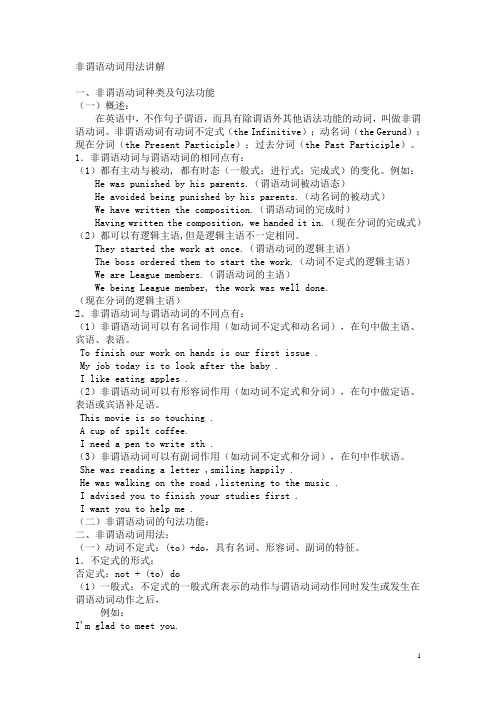
非谓语动词用法讲解一、非谓语动词种类及句法功能(一)概述:在英语中,不作句子谓语,而具有除谓语外其他语法功能的动词,叫做非谓语动词。
非谓语动词有动词不定式(the Infinitive);动名词(the Gerund);现在分词(the Present Participle);过去分词(the Past Participle)。
1.非谓语动词与谓语动词的相同点有:(1)都有主动与被动, 都有时态(一般式;进行式;完成式)的变化。
例如:He was punished by his parents.(谓语动词被动语态)He avoided being punished by his parents.(动名词的被动式)We have written the composition.(谓语动词的完成时)Having written the composition, we handed it in.(现在分词的完成式)(2)都可以有逻辑主语,但是逻辑主语不一定相同。
They started the work at once.(谓语动词的逻辑主语)The boss ordered them to start the work.(动词不定式的逻辑主语)We are League members.(谓语动词的主语)We being League member, the work was well done.(现在分词的逻辑主语)2、非谓语动词与谓语动词的不同点有:(1)非谓语动词可以有名词作用(如动词不定式和动名词),在句中做主语、宾语、表语。
To finish our work on hands is our first issue .My job today is to look after the baby .I like eating apples .(2)非谓语动词可以有形容词作用(如动词不定式和分词),在句中做定语、表语或宾语补足语。
非谓语动词用法精讲(完整版)-(共133张)

● ② 动词-ing形式的完成式一般只用来作状语, 不作定语。两个分词所表示的时间有先后,不 用分词作定语表示先时性。 【误】The temple having been destroyed by the earthquake will be rebuilt soon. 【正】The temple which has been destroyed by the earthquake will be rebuilt soon. 被地 震毁坏的庙宇很快就要重建了。
A. paying B. paid C. to be paid D. being paid
④. The repairs cost a lot ,but it’s money well ________. A.to spend B.Spent C.being spent D.Spending
4、分词作状语
B. hanging
C. hangs
D. being hung
②.Reading is an experience quite different from watching TV; there are pictures _____ in your mind instead of before your eyes.
Do you know anyone having lost a cat? × Do you know anyone who has lost a cat? √
c. 不定式作定语,指将来的时间,与被修饰词 形成主谓、动宾、同位关系或修饰关系。
The next train to arrive was from New York. This is the material ___ in the lab tomorrow.
非谓语动词讲解举例子

非谓语动词讲解举例子非谓语动词是指除了谓语动词之外的其他动词形式,包括动词不定式、现在分词和过去分词。
非谓语动词可以在句子中作主语、宾语、定语、状语等成分。
下面将分别介绍非谓语动词的形式及其用法,并举例说明。
1. 动词不定式(to+动词原形)动词不定式一般用在动词后面,可以表示目的、意图、原因、结果等。
例句:- I went to the supermarket to buy some groceries.(我去超市买了一些杂货。
)这里的不定式"to buy"表示目的。
- My friends and I decided to go hiking this weekend.(我和我的朋友决定这个周末去远足。
)这里的不定式"to go"表示动作的意图。
2. 现在分词(动词+ing)现在分词可以用作形容词,表示正在进行的动作。
例句:- The running water is so clear.(流动的水很清澈。
)这里的现在分词"running"作为形容词修饰水。
- I saw a crying child on the street.(我看到了街上一个哭泣的孩子。
)这里的现在分词"crying"作为形容词修饰孩子。
3. 过去分词(一般以-ed、-en或其他形式结尾)过去分词一般用作形容词,表示被动或完成的动作。
例句:- The broken window needs to be repaired.(破损的窗户需要修理。
)这里的过去分词"broken"作为形容词修饰窗户。
- She was thrilled to receive the unexpected gift.(她收到这个意外的礼物感到兴奋。
)这里的过去分词"unexpected"作为形容词修饰礼物。
非谓语动词还有其他用法,如作状语、宾语补足语等,下面是一些例子:- Being a doctor, he is always busy.(作状语)作为一个医生,他总是很忙。
用法讲解非谓语动词

非谓语动词1)一般式:不定式的一般式所表示的动作与谓语动词动作同时发生或发生在谓语动词动作之后,例如:I’m glad to meet you. The patient asked to be operated on at once.2)实行式:不定式的实行式所表示的动作与谓语动词动作同时发生,例如:The boy pretended to be working hard. He seems to be reading in his room.3)完成式:不定式的完成式表示的动作发生在谓语动词动作之前,例如:I regretted to have told a lie. I happened to have seen the film.★不定式的完成时还可表示“过去本想做某事但未做”的虚拟语气。
(A)should like to / would like to / would love to + 不定式的完成时。
(B)was / were to + 不定式的完成时,表示该做某事或想做但未实现。
(C)expect / hope / mean / promise / suppose / think / want/ wish + 不定式完成时,表示过去未曾实现的愿望。
1)一般式:Seeing is believing. 眼见为实。
2)被动式:He came to the party without being invited. 他未被邀请就来到了晚会。
3)完成式:We remembered having seen the film. 我们记得看过这部电影。
4)完成被动式:He forgot having been taken to Guangzhou when he was five years old.1)现在分词的主动语态:现在分词主动语态的一般式表示与谓语动词所表示的动作同时发生,完成式表示的动作在谓语动词所表示的动作之前发生,常作状语。
(完整版)非谓语的用法总结
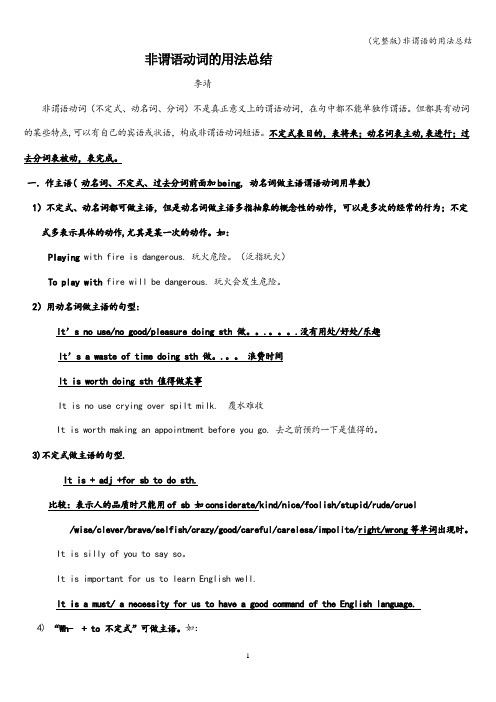
非谓语动词的用法总结李靖非谓语动词(不定式、动名词、分词)不是真正意义上的谓语动词,在句中都不能单独作谓语。
但都具有动词的某些特点,可以有自己的宾语或状语,构成非谓语动词短语。
不定式表目的,表将来;动名词表主动,表进行;过去分词表被动,表完成。
一.作主语( 动名词、不定式、过去分词前面加being, 动名词做主语谓语动词用单数)1)不定式、动名词都可做主语,但是动名词做主语多指抽象的概念性的动作,可以是多次的经常的行为;不定式多表示具体的动作,尤其是某一次的动作。
如:Playing with fire is dangerous. 玩火危险。
(泛指玩火)To play with fire will be dangerous. 玩火会发生危险。
2)用动名词做主语的句型:It’s no use/no good/pleasure doing sth 做。
.。
.没有用处/好处/乐趣It’s a waste of time doing sth 做。
.。
浪费时间It is worth doing sth 值得做某事It is no use crying over spilt milk. 覆水难收It is worth making an appointment before you go. 去之前预约一下是值得的。
3)不定式做主语的句型.It is + adj +for sb to do sth.比较:表示人的品质时只能用of sb 如considerate/kind/nice/foolish/stupid/rude/cruel /wise/clever/brave/selfish/crazy/good/careful/careless/impolite/right/wrong等单词出现时。
It is silly of you to say so。
It is important for us to learn English well.It is a must/ a necessity for us to have a good command of the English language.4) “Wh- + to 不定式”可做主语。
非谓语的用法
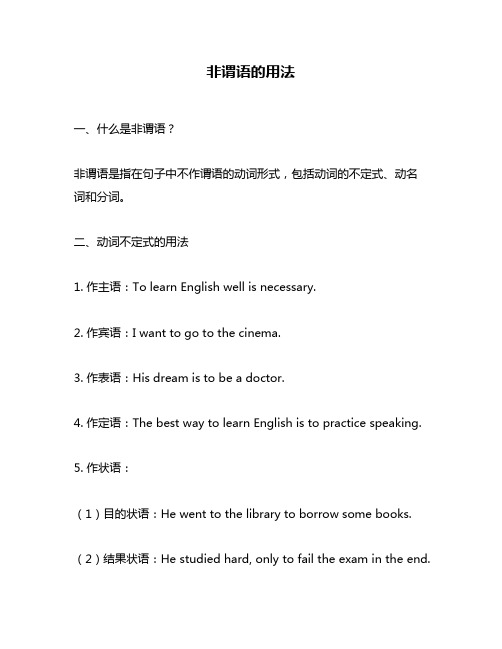
非谓语的用法一、什么是非谓语?非谓语是指在句子中不作谓语的动词形式,包括动词的不定式、动名词和分词。
二、动词不定式的用法1. 作主语:To learn English well is necessary.2. 作宾语:I want to go to the cinema.3. 作表语:His dream is to be a doctor.4. 作定语:The best way to learn English is to practice speaking.5. 作状语:(1)目的状语:He went to the library to borrow some books.(2)结果状语:He studied hard, only to fail the exam in the end.(3)原因状语:He got up early so as not to miss the train.6. 不定式的否定形式为“not+动词原形”,常用于否定意义。
三、动名词的用法1. 动名词可以作主语、宾语和表语。
(1)主语:Reading books is a good habit.(2)宾语:I enjoy reading books in my free time.(3)表语:Her hobby is swimming in the sea.2. 动名词可以与介词搭配构成介词短语,表示时间、原因、方式等。
(1)时间状语:After finishing his homework, he went to bed. (2)原因状语:For lack of money, he couldn’t buy a new car.(3)方式状语:By working hard, he got a promotion.四、分词的用法1. 现在分词和过去分词可以作定语和状语。
(1)现在分词作定语:The running water is very clear.(2)现在分词作状语:He left the room, closing the door behind him.(3)过去分词作定语:The broken vase cannot be repaired.(4)过去分词作状语:Feeling tired, he went to bed early.2. 分词也可以与连系动词be搭配构成表语。
非谓语动词讲解史上最全

非谓语动词讲解史上最全非谓语动词是英语中的一种特殊动词形式,它们在句子中通常不具备时态和人称的变化。
非谓语动词包括不定式、动名词和现在分词。
一、不定式(Infinitive)不定式由to加动词原形构成,具有动词和名词的双重特征。
不定式在句子中可以作主语、宾语、表语、定语、状语等成分。
1. 作主语:To learn a foreign language is beneficial to your career.学习一门外语对你的事业有益。
2. 作宾语:I want to visit my grandparents this weekend.我想这周末去看望我的祖父母。
3. 作表语:His dream is to become a famous writer.他的梦想是成为一名著名的作家。
4. 作定语:She has many books to read.她有很多书要读。
5. 作状语:He came to help us.他来帮助我们。
二、动名词(Gerund)动名词由动词原形加-ing构成,具有动词和名词的双重特征。
动名词在句子中可以充当主语、宾语、表语、定语、状语等成分。
1. 作主语:Swimming is my favorite sport.游泳是我最喜欢的运动。
2. 作宾语:I enjoy reading novels in my free time.我喜欢在空闲时间读小说。
3. 作表语:Her hobby is singing.她的爱好是唱歌。
4. 作定语:The running water is clear.流动的水很清澈。
5. 作状语:She went shopping after finishing her homework.她在完成作业后去购物。
三、现在分词(Present Participle)现在分词由动词原形加-ing构成,具有动词和形容词的双重特征。
现在分词在句子中可以充当定语、表语、状语等成分。
非谓语全面讲解
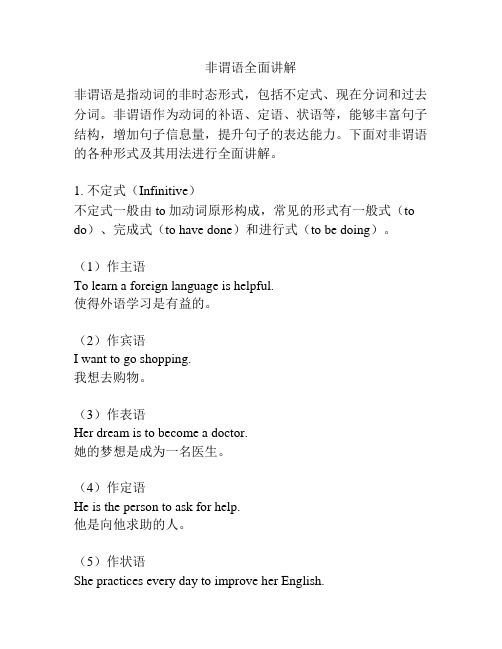
非谓语全面讲解非谓语是指动词的非时态形式,包括不定式、现在分词和过去分词。
非谓语作为动词的补语、定语、状语等,能够丰富句子结构,增加句子信息量,提升句子的表达能力。
下面对非谓语的各种形式及其用法进行全面讲解。
1. 不定式(Infinitive)不定式一般由to加动词原形构成,常见的形式有一般式(to do)、完成式(to have done)和进行式(to be doing)。
(1)作主语To learn a foreign language is helpful.使得外语学习是有益的。
(2)作宾语I want to go shopping.我想去购物。
(3)作表语Her dream is to become a doctor.她的梦想是成为一名医生。
(4)作定语He is the person to ask for help.他是向他求助的人。
(5)作状语She practices every day to improve her English.她每天练习以提高自己的英语。
2. 现在分词(Present Participle)现在分词是动词的进行式形式,一般以-ing结尾。
(1)作定语The running water is very clear.流动的水很清澈。
(2)作状语Walking along the street, I found a lost cat.我在街上走的时候,发现了一只走失的猫。
(3)作补语I saw him standing in the corner.我看见他站在角落里。
3. 过去分词(Past Participle)过去分词是及物动词的过去分词形式或系动词be的过去分词形式,通常以-ed结尾或者是不规则变化的形式。
(1)作定语The broken window needs to be repaired.需要修理那扇破窗户。
(2)作状语They arrived at the airport, tired and hungry.他们到达机场时,又累又饿。
常用非谓语用法大总结

常用非谓语用法大总结非谓语用法是指动词的非谓语形式(不带主语和谓语),包括不定式、动名词和现在分词、过去分词。
非谓语在句子中具有特定的功能和作用,可以作主语、宾语、状语等,能够丰富句子结构,增强表达的灵活性。
以下是常用的非谓语用法大总结:一、不定式用法:1.作主语:To love is to live.(爱即是生活。
)To err is human, to forgive divine.(人非圣贤,孰能无过。
)2.作宾语:I hope to see you.(我希望见到你。
)He wants to go shopping.(他想去购物。
)3.作表语:4.作宾补:They agreed to help us.(他们同意帮助我们。
)I want to eat some fruit.(我想吃些水果。
)5.作定语:I have a book to read.(我有一本书要读。
)This is the place to be.(这是最佳位置。
)6.作状语:She went to the store to buy some milk.(她去商店买牛奶。
)7.动词不定式的形式和功能:主动形式:to +动词原形被动形式:to be +过去分词8.一些常见的固定搭配:to be honest(老实说), to be frank(坦白说), to be fair (公平地说), to be sure(确切地说), to tell the truth(实话告诉你), etc.二、动名词用法:1.作主语:Smoking is harmful to health.(吸烟对健康有害。
)Learning is a lifelong process.(学习是一辈子的事。
)2.作宾语:I enjoy swimming.(我喜欢游泳。
)She suggested watching a movie.(她建议看电影。
)3.作表语:His hobby is playing basketball.(他的爱好是打篮球。
非谓语动词讲解以及例句

非谓语动词讲解以及例句非谓语动词是指动词的非谓语形式,不受主语的人称和数的限制,常用作句子的宾语、定语或状语。
非谓语动词包括动名词、不定式和分词三种形式。
一、动名词(-ing形式):1. 作主语:Being kind to others is always a good thing to do.(对他人友善总是值得做的好事。
)2. 作宾语:I enjoy swimming in the ocean.(我喜欢在海里游泳。
)3. 作宾补:She made a decision, ending their relationship.(她做出了一个决定,结束了他们的关系。
)4. 作定语:The running water is so clear and refreshing.(流动的水非常清澈和令人神清气爽。
)5. 作状语:Knowing the answer, he raised his hand.(知道答案后,他举手了。
)二、不定式(to + 动词原形):1. 作主语:To learn a new language is challenging but rewarding.(学习一门新语言是具有挑战性但值得的。
)2. 作宾语:She wants to visit Paris next year.(她想明年去巴黎旅游。
)3. 作宾补:I need to finish this report by tomorrow.(我需要明天之前完成这份报告。
)4. 作定语:He is the best person to ask for help.(他是寻求帮助的最佳人选。
)5. 作状语:She went to the library to study.(她去图书馆学习。
)三、分词:1. 现在分词(-ing形式):The crying baby woke up the entire neighborhood.(哭闹的婴儿吵醒了整个社区。
非谓语动词讲解 超全

非谓语动词讲解超全非谓语动词是指不具有人称和数的动词形式,不需要依附主语就可以使用的动词形式。
非谓语动词包括动词不定式、动名词和现在分词等形式。
非谓语动词的使用可以丰富句子结构,增强表达效果,表达出动作的进行、完成、目的、原因等不同的语义关系。
一、动词不定式动词不定式是动词的一种非谓语形式,由“to” + 原形动词构成,具有名词、形容词或副词的特性。
1. 作主语:To learn English well is my goal.(学好英语是我的目标。
)2. 作宾语:I want to take a nap.(我想睡个觉。
)3. 作宾补:She found it difficult to solve the math problem.(她发现解决这个数学问题很困难。
)4. 作表语:My dream is to become a teacher.(我的梦想是成为一名教师。
)5. 作状语:He left the room to make a phone call.(他离开房间去打电话。
)二、动名词动名词是动词的一种非谓语形式,多用于表示动作的稳定状态或被动的形式,常常作主语、宾语或介词的宾语。
1. 作主语:Swimming is my favorite sport.(游泳是我最喜欢的运动。
)2. 作宾语:I enjoy reading books.(我喜欢阅读书籍。
)3. 作宾补:He kept silent, not wanting to reveal the secret.(他保持沉默,不想泄露秘密。
)4. 作介词的宾语:She is good at playing the piano.(她擅长弹钢琴。
)三、现在分词现在分词是动词的一种非谓语形式,通常以-ing结尾,可以表示主动、进行、伴随等含义。
1. 作定语:The running dog scared the child.(奔跑的狗吓唬了孩子。
非谓语动词用法讲解与运用
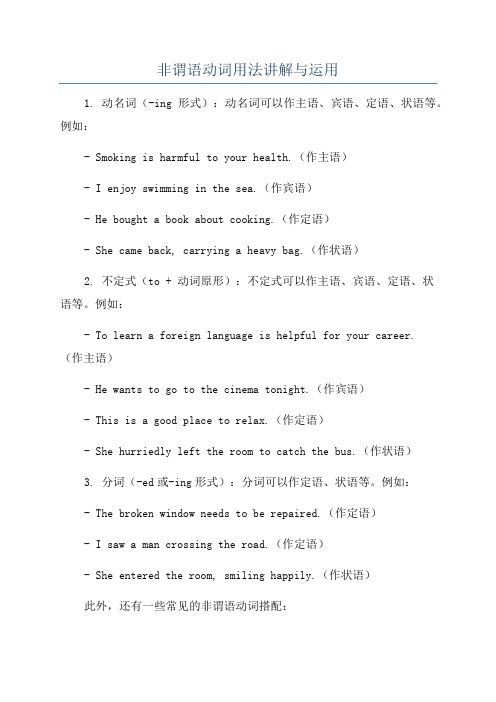
非谓语动词用法讲解与运用1. 动名词(-ing形式):动名词可以作主语、宾语、定语、状语等。
例如:- Smoking is harmful to your health.(作主语)- I enjoy swimming in the sea.(作宾语)- He bought a book about cooking.(作定语)- She came back, carrying a heavy bag.(作状语)2. 不定式(to + 动词原形):不定式可以作主语、宾语、定语、状语等。
例如:- To learn a foreign language is helpful for your career.(作主语)- He wants to go to the cinema tonight.(作宾语)- This is a good place to relax.(作定语)- She hurriedly left the room to catch the bus.(作状语)3. 分词(-ed或-ing形式):分词可以作定语、状语等。
例如:- The broken window needs to be repaired.(作定语)- I saw a man crossing the road.(作定语)- She entered the room, smiling happily.(作状语)此外,还有一些常见的非谓语动词搭配:- 动名词搭配:keep doing sth.(坚持做事)、can't help doing sth.(忍不住做事)、enjoy doing sth.(喜欢做事)等。
- 不定式搭配:(be) going to do sth.(打算做事)、would liketo do sth.(想要做事)、be able to do sth.(能够做事)等。
- 分词搭配:a man dressed in black(一个穿着黑色衣服的男人)、a book written by Shakespeare(一本由莎士比亚写的书)等。
非谓语用法大总结

非谓语用法总结一、非谓语动词的含义非谓语动词首先是一种动词形式,其次是这种动词形式不能做谓语,综合这两点,我们将其叫做非谓语动词。
eg:The thief is said to have been arrested.据说小偷已经被抓住了。
⑥完成进行式:to have been doing (表示主动和完成进行)eg: She is said to have been working in the factory over the last 20 years.据说在过去的20年里,她一直在这家工厂工作。
(2)动名词①基本形式:doing (表示主动)eg: Travelling in space by ordinary people will be common in the future.在未来,普通人在太空旅行将会是普遍的事情。
②被动式:being done(表示被动)eg: Freddy and his band could go nowhere without being followed by their fans.弗雷迪和他的乐队到哪里都被他们的粉丝跟着。
③完成式:having done(表示主动和完成)eg: I have no idea of his having done such a thing against you.我不知道他做过这样一件违背你的事情。
④完成被动式:having been done(表示被动和完成)eg: Many customers complain of having been given short weight at that shop.很多顾客抱怨在那家商店被缺斤少两过。
(3)现在分词①基本形式:doing (表示主动和进行)eg: He sat there,reading a newspaper.他坐在那里,读着一张报纸。
②被动式:being done(表示被动和进行)eg: The area being studied may be rich in coal.这个正在被研究的地方可能富含煤。
非谓语动词用法总结

非谓语动词用法总结非谓语动词主要包括不定式、动名词和现在分词。
为了区分这三种不同的非谓语动词的用法和含义,我们将分别从三种非谓语动词在句子中做主语、宾语、宾语补足语、定语、状语、表语以及一些特殊结构句型等角度来区分其用法和细微含义。
接下来,小编给大家准备了非谓语动词用法总结,欢迎大家参考与借鉴。
非谓语动词用法总结1.不定式和动名词作主语的区别(1)动名词作主语通常表示抽象动作;而不定式作主语表示具体动作。
Smoking is prohibited(禁止)here.这里禁止抽烟。
(抽象)It is not very good for you to smoke so much.你抽这么多烟对你身体很不好。
(具体)(2)动名词作主语时,通常用以表示一件已知的事或经验。
不定式短语通常用来表示一件未完成的事或目的。
Climbing mountains is interesting.爬山很有趣。
(经验)Driving a car during the rush hour is tiring.在高峰时刻开车令人厌烦。
(经验)(3)不定式做主语,一般用it当形式主语,把作主语的不定式短语后置。
It took me only five minutes to finish the job.2.不定式、动名词和分词作表语的区别(1)不定式作表语1)不定式作表语一般表示具体动作,特别是表示将来的动作。
To do two things at a time is to do neither.--次做两件事等于未做。
What I would suggest is to start work at once.我的建议是立刻开始干。
2)如果主语是不定式(表示条件),表语也是不定式(表示结果)。
To see is to believe.百闻不如一见。
To work means to earn a living.工作就是为了生活。
3)如果主语是以aim, duty, hope, idea, happiness, job,plan,problem,purpose,thing,wish等为中心的名词,或以what引导的名词性从句,不定式作表语是对主语起补充说明作用。
- 1、下载文档前请自行甄别文档内容的完整性,平台不提供额外的编辑、内容补充、找答案等附加服务。
- 2、"仅部分预览"的文档,不可在线预览部分如存在完整性等问题,可反馈申请退款(可完整预览的文档不适用该条件!)。
- 3、如文档侵犯您的权益,请联系客服反馈,我们会尽快为您处理(人工客服工作时间:9:00-18:30)。
3.用不定式作定语的几种情况: 不定式表将来: I borrowed some books to read during my holiday. 用来修饰被序数词、最高级或no, all, any 等限定的中 心词。如: He was the best man to do the job. She was the first woman to win the gold medal in the Olympic Games. Women and children were the first to get into the lifeboats. 用来修饰的词是抽象名词时,常见的有:ability, chance, idea, fact, excuse, promise, answer, reply, attempt, belief, way, reason, moment, time 等。如: Do you have the ability to read and write English ? I have a chance to go sight –seeing.
② have sb. / sth. doing 使/让某人/物持续地做某事(现 在分词表示主动,正在进行) get sb. / sth. doing 使某人/物开始行动起来 如:The peasants had the tractor working day and night at the harvest time. 农忙时,农民们让拖拉机夜以继日地干活。 The captain got the soldiers moving toward the front after a short rest. 休息了片刻之后,上尉让士兵们开始朝前线行进起来。 注意:“have sb. doing‖若用于否定句中,其中have 有 “容忍”之意。如: I won’t have you speaking to your parents like that. 我不会让你那样子跟你的父母说话。 Don’t have the water running all the time. 不要让水流 个不停。
★分词、不定式作宾补用法要点 一、分词、不定式作宾语补足语的区别 1.感官动词see, watch, observe, look at, hear, listen to, notice 等和使役动词have 后面的宾补有三种 形式,即原形动词(不带to 的不定式)、现在分词和过 去分词。现在分词表主动或正在进行,过去分词表被动 或完成,动词原形表主动和完成。如: I heard her sing an English song just now. 刚才我听见她唱了一首英文歌。 I heard her singing an English song when I passed by her room yesterday. 昨天经过她房间时,我听见她在唱英文歌。 I heard the English song sung many times. 我多次听到有人唱这首英文歌。
注意:不及物动词的过去分词作宾补表完成和状态。 如: I looked down at my neck and found my necklace gone. (状态) I was surprised to find my hometown changed so much. (完成)
2.leave 后接三种形式作宾补时,其中的leave 保 留了原来之义“留下”,但表达的确切之义应是 “使……处于某种状态)。 leave sb. doing sth. 让某人一直做某事(宾语和宾 补之间是主谓关系,表示动作正在进行。) leave sth. undone 留下某事未做(宾语和宾补之间 是动宾关系,表示被动和完成,一般以undone, unfinished, unsettled, untouched 为多) leave sb. to do sth. 留下某人做某事 leave sth. to be done 留下某事要做(不定式表示 将来的动作。) 如:It’s wrong of you to leave the machine running.
③ have sb. do sth. (get sb. to do sth. ) 使/让/叫某人去 做某事 如:Mother had me go to the shop and buy some salt. I can’t get him to stop smoking. He won’t listen to me.
二、下列动词后跟带to 的不定式作补语: advise, allow, ask, beg, cause, encourage, expect, forbid, force, get, intend, invite, like, love, order, persuade, prefer, require, teach, tell, want, warn, wish, 等。如: ① An army spokesman stressed that all the soldiers had been ordered to issue clear warning before firing any shots. ② The teacher asked us not to make so much noise. ③ The flu is believed to be caused by viruses that like to reproduce in the cells inside the human nose and throat.
非谓语动词经典用法讲解
。
★命题规律 1.考查立意较低,主要考查的是非谓语的一些最基本的用 法。但是,题目的设置注重了情景化和结构复杂化,加大 了考生对题干句的理解难度。 2.设问的角度呈现出多样化趋势,不仅仅是非谓语间的 互相干扰。 ★命题趋势 不容置疑,高考将继续加强对非谓语动词的考查,试题的 特征将继续呈现出“情景化”和“设问角度的多样化”的 趋势,但试题的难度将会有所控制。 ★解题思路 ① 解析句子结构,确定设空在句子中充当的功能(如状 语、定语或宾补); ② 找准相关动词的逻辑主语,确定该动词与逻辑主语是 什么关系(主动还是被动);
3.have, get 后接三种形式作宾补时,其中have, get 表示“使、让、叫”之意。 ① have sth. done = get sth. done ―使/让某事由别 人去做”(叫/让某人做某事)。如 I’ll have /get my bike repaired tomorrow. 此外,have sth. done 还表示“使遭受……‖之意。 如 Tom had his leg broken while playing football. Mr. Smith had his house broken into while he was away on holiday.
2. 介词of 或for的宾语就是非谓语动词的逻辑主语。例 如: It’s kind of you to tell me the news . (you 是 to tell 的逻辑主语) 这个句子中,it是形式主语,句子的真正主语是 to tell me the news. It is impossible for you to finish so much work in so short a time . (you 是to finish 的逻辑主语) 3. 复合结构中的宾语就是非谓动词的逻辑主语。例如: The doctor asked me to answer her question . (me 是to answer 的逻辑主语) I saw him playing at the river side . (him 是 playing 的逻辑主语)
★不定式、分词作定语用法要点 一、不定式作定语 1.作定语的不定式如果是不及物动词,或者不定式 所修饰的名词或代词是不定式动作的地点、工具等, 不定式后面须有相应的介词。如: The Browns have a comfortable house to live in. There is nothing to worry about. Please give me a knife to cut with. Here is some paper for you to write on. 但是,不定式所修饰的名词如果是time, place 或way 时,不定式后面的介词习惯上省去。如:He had no money and no place to live (in). We found a way to solve this problem (in).
2.当作定语的不定式所修饰的名词或代词是不定式 动作的承受者时,不定式既可以用主动语态,也可用 被动语态,但其含义有所不同。试比较: Have you anything to send ? 你有什么东西要寄吗? (不定式to send 的动作执行者是“你”) Have you anything to be sent ? 你有什么要(我或 别人)寄的东西吗? (不定式to be sent 的动作执行者是“我”或“别 人”)
③ 搜索句子中相关的时间信息,确定非谓语动词的恰 当形式; ④ 将该选项置入空中,看是否能够做到字从意顺,或 是否能传主语是怎么一回事?
逻辑主语: 是非谓语动词动作的执行者或承受者; 它们在逻辑上存在着主谓关系或动宾关系,但不 能直接作非谓语动词的主语,因此叫逻辑主语。
逻辑主语的判断:
1. 句子主语就是非谓语动词的逻辑主语,它们之间是逻 辑上的主谓关系或动宾关系。例如: She likes helping others .(she 就是 helping 的逻 辑主语) Moved by my words , her father told me the truth . (her father 是 moved 的逻辑主语)
三、不定式、现在分词作宾补小窍门 下列动词后在主动语态中用不带to 的不定式作补语,但 在被动语态中要加上to: 它们是“吾看三室两厅一感觉”——5看(look at, see, watch, notice, observe);3使(make, let, have);2 听(listen to, hear);1感觉(feel)。以上动词还可用 现在分词作宾语补足语(5+3+2+1-2+4):即以上动词除 let, make 外都可以用现在分词作宾语补足语,此外find, catch, keep, have 也可以用现在分词作宾语补足语。 如:At that time, I found him crying in the street. He was caught stealing. I’m sorry to have kept you waiting for such a long time. The missing boys were last seen playing near the river
